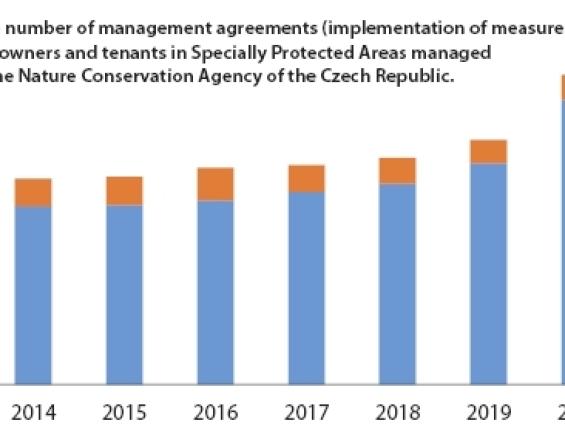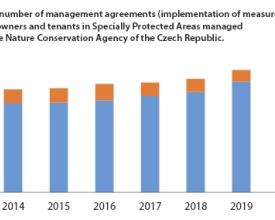
Management Agreements with Landowners as a Tool for Nature Conservation

Ten years ago, the Nature Conservation Agency of the Czech Republic (NCA CR) began to conclude agreements on management through public contracts, setting up both management measures to be implemented and providing landowners or tenants with a subsidy/subvention. Consequently this practice has been applied step-by-step, also by other State Nature Conservancy authorities, particularly Regional Offices.
At present the agreements on management are one of the principal and commonly used tools in cooperation with land managers. The NCA CR is currently taking active steps to further expand the type of cooperation with landowners, our most important partners in practical nature conservation.
The highest type of agreement with the landowner is the so-called comprehensive management agreement. Its aim is to formulate clear rules and conditions for management by the owner or user. These are long-term agreements, usually for five to ten years.
Contexte
Challenges addressed
The rules for concluding agreements were established step-by-step. When setting up the process, the NCA CR used the relevant interpretation of the Ministry of the Environment of the Czech Republic; however, in order to ensure compliance with the budgetary rules, they had to build the entire system from scratch. The first step was to distinguish between commonly assigned activities in nature conservation and landscape protection and to determine the usual costs for their implementation. Today, the result is a unified code lists of activities in nature conservation and landscape protection linked to costs of common measures and consequently for planning and documenting the interventions having been made in nature and the landscape. Without the implementation of these demanding steps, the concluding public contracts (in particular the provision of financial contributions for the implementation of measures) would be difficult and complicated, with the risk of inefficient use of public funds.
Emplacement
Traiter
Summary of the process
Without the implementation of these demanding steps, the concluding public contracts (in particular the provision of financial contributions for the implementation of measures) would be difficult and complicated, with the risk of inefficient use of public funds. The standardization of management activities also makes it possible to develop data support tools, which further facilitates the planning and signing agreements and their documentation in particular.
Building Blocks
Possibilities to pay for land management to the owner from state budget
In order to be able to pay fees for agreed management with landowners, the legislation had to be approved allowing such expenditures from the state budget.
Enabling factors
Concluding agreements on land management for nature conservation, and agreements on management in protected areas, and paying a financial contribution for its implementation has been enshrined in the Nature Conservation and Landscape Protection Act since the beginning in 1992. However, the absence of general legislation on the concept of public contracts had long been an obstacle to its application in practice. This legislation was finally approved as the Administrative Procedure Code in 2006.
Lesson learned
It has been crucial that such a paragraph in the state legislation exists allowing to use state budget to pay for services associated with the management of naturally valuable areas even on a private land.
Setting up procedure for financial contributions for management activities
In order for the NCA CR to be able to pay financial contributions to landowners, it was necessary to clarify compliance with budgetary rules. In order to ensure compliance with the budgetary rules, NCA CR built the entire system from scratch. The first step was to distinguish between commonly assigned management activities in nature conservation and to determine the usual costs for their implementation. Today, the results are unified in a code list of activities in nature conservation linked to costs of common management measures.
Enabling factors
The most challanging and the crucial factor is to agree on costs of common management activities (e.g. cost of mowing 1 ha of a meadow, creating 1 m2 of a water pond, etc.) with the Ministry of Environment and with practical land managers.
Lesson learned
Once the list of activities and associated costs of common management measures is agreed upon, it is quite easy to make annual updates, the signing of individual contracts is relatively fast and easy and the costs are fully transparent.
Impacts
Public contracts with landowners and land users have become a commonly used form for agreement on practical measures in Specially Protected Areas, as well as providing a payment for their implementation. Unfortunately, multi-annual agreements have been less common so far, although they save time and effort on administrative steps for both the NCA CR and the land manager.
At present, the NCA CR concludes and signs over 1,100 agreements per year and around one hundred agreements are signed as long-term (up to ten years).
Management agreements arise from the mutual communication of the owner (user) of the land and the State Nature Conservancy authority. By discussing them, and subsequently signing them, a long-lasting commitment has been fulfilled which is repeated in a number of strategic documents on nature conservation and landscape protection, namely to implement nature conservation and landscape protection with the participation of landowners and land managers. Nature conservation is becoming clearer, more understandable, and predictable for partners. The comprehensive and long-term agreements on management measures in Specially Protected Areas have proved successful and therefore, it is necessary to develop this instrument further.
Beneficiaries
There is a higher degree of understanding; firstly by the land manager, about the needs to ensure the existence of objects of protection, and secondly by the State Nature Conservancy authority, about the land manager’s abilities.







